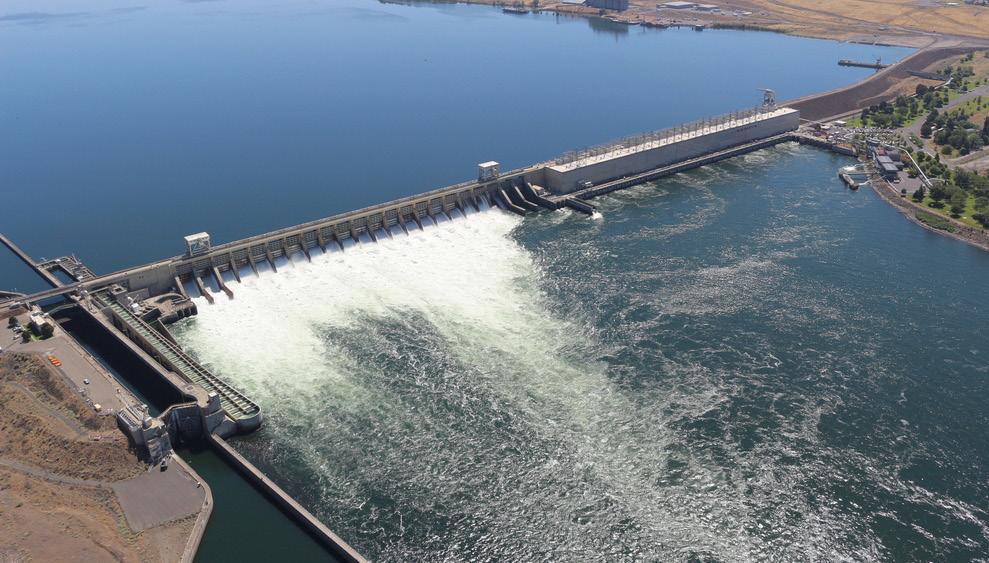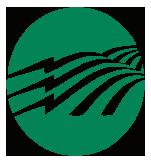Hydro is our power!
solar and wind. While these sources are clean, they only provide intermittent power and offer limited reliability.

As you know, the Northwest region’s main source of power comes from our hydroelectric dams located throughout our rivers. The Pacific Northwest receives over 85 percent of its renewable energy from our hydroelectric system according to the Northwest Power and Conservation Council. The remaining small percentage of power comes from wind, biomass, nuclear and solar. According to Bonneville Power Administration, the hydropower plants in our dam system convert around 90 percent of falling water into electrical energy. By comparison, a wind turbine has only a 50 percent conversion rate at times of peak wind, and solar is only functioning when the sun is shining. Therefore, our regions’ most dependable,
clean and affordable source of power remains to be hydro.


In 2020, Washington state passed the Clean Energy Transformation Act (CETA), which requires all state electric utilities to become carbon-neutral by 2030 and 100 percent carbon-free by 2045. Inland Power understands the importance of this law and is committed to a carbon-free goal. Maintaining and investing hydroelectricity is key to achieving this measure. Without our hydro system in place, Washington could face the same struggles that California is experiencing. California is currently over 66 percent reliable on thermal and nonrenewable sources. The state has limited hyrdo energy sources, with the majority of their renewable generation coming from

Inland Power is committed to advocating for its members and we will continue our focus to remain vocal about the need for hydro during Washington’s 2023 legislative session. Our region cannot solely rely on wind and solar based on the limited power and reliability they provide. We know that in order to achieve CETA’s carbon-free goal, our hydroelectric dams must stay intact.
We encourage our members to get involved and help us in our mission to keep utilities affordable and protect our power supply. To find out how you can get involved, visit our Grassroots Action Team page at inlandpower.com/grassroots-action, and to learn more about hydropower, visit inlandpower.com/hydropower

March 2023 Inland Power LightReading inlandpower.com Inland Power is my cooperative!
Inland Power Community Foundation Scholarship Deadline Lighting Tips ENERGY inside... SAFETY Safely working around powerlines
GIVING
14 million households are served by the Northwest’s hydropower.
The dos and don’ts when using a portable generator

Whenstorms hit there is always greater potential for power outages. If you plan to use a portable generator in the event of an outage, Inland Power reminds you to play it safe.

With proper use and maintenance, portable generators can provide great convenience during an outage. However, when generators are used incorrectly, they can be extremely hazardous. In a 2022 report, the Consumer Product Safety Commission estimated 85 U.S. consumers die every year from carbon monoxide (CO) poisoning caused by gasoline-powered portable generators. Here are 10 dos and don’ts to follow when using portable generators:
1. DO: Install backup CO alarms.
2. DO: Keep children and pets away from portable generators at all times.
3. DO: Position generators at least 25 feet outside the home, away from doors, windows and vents that can allow CO to enter the home.
4. DO: Ensure your generator is properly grounded. Use a portable ground fault circuit interrupter (GFCI) to prevent electric shock injuries.
5. DO: Use three-pronged extension cords that are rated to handle the load of the generator. Inspect extension cords for cuts, frays or other damage before use.
6. DON’T: Operate a generator inside your home or an enclosed (or partiallyenclosed) space. Generators produce high levels of CO, which can be deadly.
7. DON’T: Open windows or doors while the generator is running.
8. DON’T: Rely on generators as a fulltime source of power. They should only be used temporarily or in emergency situations to power essential equipment or appliances.
9. DON’T: Overload generators. They should only be used to power essential equipment. Make sure your generator can handle the load of the items you plan to power.
10. DON’T: Connect generators directly



into household wiring unless you have an appropriate transfer switch installed. If a generator is connected to a home’s wiring without a transfer switch, power can backfeed along power lines and electrocute utility lineworkers making repairs. While generators provide convenience during power outages, they can quickly become hazardous––even deadly––if improperly operated. Before you operate a portable generator, be sure to thoroughly read the owner’s manual for important safety information and tips.
If you have questions about proper use of portable generators, we’re here to help. Visit and learn more at inlandpowerportable-generator-safety.com.
E “ OUR mission IS OUR members.” –MISSION STATEMENT
How do we compare? Washington and Idaho have the lowest residential electricity rates in the country! Inland Power 6.8¢ cents per kWh
Inland Electric Rates

Effective April 1, 2023
Dear Valued Member,
As an Inland Power member, your electric rates are amongst the lowest in the nation. Our goal is to maintain these low rates while continuing to successfully provide all our members with safe and reliable electricity. We understand the need to be proactive in our efforts to keep rates affordable, while improving our system infrastructure and distribution. Although rate increases are never popular, they are necessary at times and based on rising demand and ongoing supply chain issues, we are experiencing increased costs for equipment and labor. As a result, effective April 1, 2023, Inland Power members will see a slight increase in their service availability charge for residential, commercial and small irrigation. Our kWh charge will remain at the same rate and members will not see an increase at this time.
We appreciate the opportunity to be your utility company and to serve you. If you have questions, please contact us at inlandpower@inlandpower.com.
Safely working around power lines
Whether you’re a homeowner or contractor, chances are at some point we all will need to perform some work outdoors in the vicinity of power lines. There are several things you should know to stay safe working around power lines this summer. Before starting work do a quick hazard assessment. Consider where you’ll be working, what kinds of tools or equipment you’ll be using, and identify any power lines in the area. If you’ll be disturbing the soil, be sure to call 8-1-1 at least two business days beforehand to have the locations of underground lines marked.
If you’ll be working around overhead lines, make sure to keep plenty of distance between yourself, including tools or equipment you’re using, and power lines. For work around the distribution lines that bring power to buildings the minimum distance is 10 feet. A greater clearance is required if operating a crane or working around higher voltage lines. If you’re not sure of the minimum required clearance check with your local electric utility. If your work needs to be performed within the minimum required clearance distance you’ll need to contact the utility to have lines de-energized.
Choose the right tools and equipment and know how to operate them safely around power lines. Keep conductive objects away from power lines and never use metal ladders around electricity – choose wood or fiberglass instead. If digging around underground lines, always dig carefully and only with hand tools within two feet of locate marks.
Be sure to follow these tips and work safely around power lines this summer –your life depends on it!

Inland Power is my cooperative!
RESIDENTIAL & SEASONAL Service Availability Charge (single phase) $24.55/mo Current Rate Rate Effective April 1, 2023 $26.55/mo Service Availability Charge (three phase) $34.40/mo $37.20/mo kWh Charge $0.0680/kWh $0.0680/ kWh Outdoor Lighting / Street Lighting $10.16 to $21.50/mo* *Published rates include a 5 percent discount for payments made by the due date. Charges will be increased 5 percent for late payment. COMMERCIAL & IRRIGATION Service Availability Charge (single phase) $24.55/mo Current Rate Rate Effective April 1, 2023 $26.55/mo Service Availability Charge (three phase) $34.40/mo $37.20/mo kWh Charge $0.0700/kWh $0.0700/kWh GENERAL RESIDENTIAL OR SMALL COMMERCIAL Commercial Demand Charge (over 50kW) $7.82/kW $7.82/kW Service Availability Charge $365/mo kWh Charge $0.057/kWh $0.057/kWh LARGE COMMERCIAL Demand Charge (over 50 kW) $7.82/kW $7.82/kW $400/mo Service Availability Charge (single phase) $24.55/mo Service Availability Charge (three phase) $34.40/mo $37.20/mo SMALL IRRIGATION (LESS THAN HP) kWh Charge $0.0680/kWh $0.0680/kWh $26.55/mo HP Charge $6.88/hp annually LARGE IRRIGATION (75+ HP) kWh Charge (May - Sept.) Peak Demand Charge kWh Charge (Oct. - April) $6.78/kW $0.0380/kWh $0.0470/kWh
Areminder to parents and students - the Inland Power Community Foundation is pleased to offer 15 - $1,000 scholarships for the 2023/2024 school year. These scholarships are active for current Inland Power members and their children. This includes college students who are members or students who can still be claimed as legal dependents of Inland Power members. A legal dependent is one who can be claimed on their parent or guardian’s tax return.



The application deadline is fast approaching and is Thursday, April 13, 2023. The Foundation will conduct the review process in May and recipients will be selected and notified in June.
Past scholarship recipients may reapply. However, at least ten of the 15 scholarships will be reserved for new applicants.


Applications have been sent to high school

counseling offices within the Inland Power service territory, or can be found on our website at inlandpower.com/scholarships Funding for the Inland Power Excellence Award is made possible by the Inland Power Community Foundation. The Foundation’s committee also serves as the scholarship committee.
The Inland Power Community Foundation was developed to generate and collect charitable donations to improve the quality of life for the communities we serve through individual, family and nonprofit organization donations. To learn more about the foundation, visit inlandpower.com/community-foundation
If you wish to make a donation to the foundation, please email to community-foundation@inlandpower.com


10110 W Hallett Rd. Spokane, WA 99224 MAIN OFFICE
TOLL FREE
QUESTIONS
PAYMENT SERVICES
ENERGY CONSERVATION AND REBATES (509) 789-1801 EMAIL inlandpower@inlandpower.com SOCIAL Inland Power
(509) 747-7151
(800) 747-7151 BILLING
(509) 789-4277
(855) 386-9903
Scholarship deadline approaching - April 13, 2023!
OUR MISSION IS OUR MEMBERS
gettouch in
















